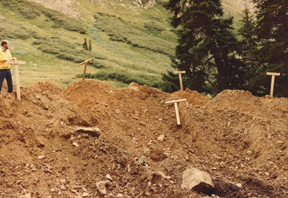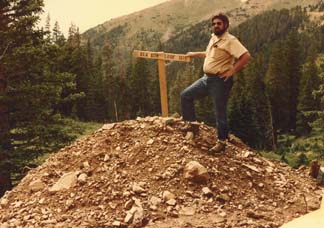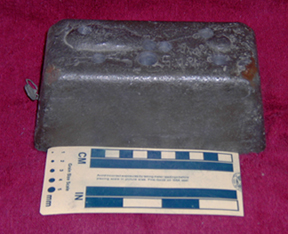Geotimes

Untitled Document

Feature
Investigating Mining
Frauds
David M. Abbott Jr.
I was a geologist for the U.S. Securities and Exchange Commission (SEC) for
21 years. My combination of profession and employer prompted many people to
ask, "You're a what for whom?" This is a natural enough question concerning
an agency known for its lawyers and accountants, not for its geologists and
engineers. The answer was simple: "mines and oil and gas wells."
 My
duties fell into two major categories: assisting mining and oil and gas firms
that were trying to comply with full disclosure provisions of the securities
laws, and investigating and helping in the prosecution of those defrauding their
investors. The latter category is the area of forensic geology — using
earth science to investigate crimes, particularly cases brought to court. Investigation
and presentation of technical evidence and opinions regarding mining fraud cases
is a major area of forensic geology.
My
duties fell into two major categories: assisting mining and oil and gas firms
that were trying to comply with full disclosure provisions of the securities
laws, and investigating and helping in the prosecution of those defrauding their
investors. The latter category is the area of forensic geology — using
earth science to investigate crimes, particularly cases brought to court. Investigation
and presentation of technical evidence and opinions regarding mining fraud cases
is a major area of forensic geology.
These piles of tailings from an abandoned
mine in Swandyke, Colo., were salted with fool’s gold to trick investors
into thinking the pile had valuable ore. Each pile has a wooden “T”
sign with a serial number so that an investor could identify an individual pile.
All photos courtesy of David M. Abbott Jr.
Mining fraud has probably been around in one form or another for centuries.
Georgius Agricola, in his 1556 De Re Metallica, the first book on everything
related to mining, noted that "a prudent owner, before he buys shares,
ought to go to the mine and carefully examine the nature of the vein, for it
is very important that he should be on his guard lest fraudulent sellers of
shares should deceive him."
What is a fraud? The simplest definition I know is that fraud is "theft
by lying," the claiming of that which is not so. One of the most infamous
definitions of a mine is "a hole in the ground owned by a liar" (a
quote that was attributed to Mark Twain in The Autobiography of John Hays
Hammond but which appears nowhere in Twain's works and has not be proven
authentic).
In my years at SEC, I had the opportunity to investigate several cases involving
classic fraud, gathering key evidence, even though I usually was not able to
present it in court. Following are just a few of my favorites.
Digging up dirt
 A number
of the cases I investigated are known as "dirt pile" cases. In order
to avoid the statutory definition of a security, which includes the phrase,
"undivided interest in oil and gas or other mineral right," investors
buy a specific very small volume (a few tons or cubic yards) of ground or a
specified pile of "ore" that is guaranteed to contain a specified
amount of gold and other precious metals. If the pile or volume does not contain
the minimum guaranteed amount, enough additional material is added to an investor's
pile to make up the difference.
A number
of the cases I investigated are known as "dirt pile" cases. In order
to avoid the statutory definition of a security, which includes the phrase,
"undivided interest in oil and gas or other mineral right," investors
buy a specific very small volume (a few tons or cubic yards) of ground or a
specified pile of "ore" that is guaranteed to contain a specified
amount of gold and other precious metals. If the pile or volume does not contain
the minimum guaranteed amount, enough additional material is added to an investor's
pile to make up the difference.
Robert Fusfeld, an attorney for the Securities
and Exchange Commission, stands atop an investor’s pile of “ore”
on the road to Swandyke, Colo. This particular pile was composed of dirt from
the road and was so barren that the promoters had thrown a couple of fool’s
gold-bearing rocks from nearby mine dumps on the pile.
Because the investor "owns" his dirt pile, he could come to the site
and mine and process it, or he can hire a supposedly independent contractor
to do the mining and processing to recover the precious metals. Investors invariably
take the latter option.
Typically, each dirt pile has a wooden sign with a serial number so that an
investor can identify his or her individual pile. In the case of an abandoned
mine in Swandyke, Colo., the piles were composed of the tailings — rock
deemed useless by the miners. Because the tailings did not actually contain
valuable minerals in quantities large enough to be economic, the promoters in
this particular case salted the surface of the piles with fool's gold, or pyrite-rich,
samples. Another company promoting such ventures produced a marketing video
tape showing how these investments worked. The video was titled How to Turn
Dirt into Gold.
Unfortunately, in this case and most of the other cases where I had excellent
evidence of fraud, defense attorneys used various means to keep me from testifying,
frequently by settling the case by consent without admitting or denying the
allegations made in SEC's complaint.
A dirt pile case in which I was able to testify involved properties in French
Guiana. Those who have seen the movie Papillon will recall that French
Guiana was a French penal colony until shortly after World War II. One of the
tasks the prisoners performed was the digging of prospect holes in the gold
placers (alluvial deposits) that occur in the central part of the country.
To reach the site of this scam, my colleagues and I left from the town of Saint-Laurent
du Maroni, on the Maroni River, the border between French Guiana and Suriname.
Saint-Laurent was also the site of one of the major French prisons, which was
cleaned up and used for part of the movie. The placer fields were about 180
kilometers south along a road bulldozed through the jungle.
Although the properties contained gold, it was indeed a fraud: The investors
were not informed that only French citizens could own the gold. American companies
could be contracted to mine the gold, but American investors could not receive
the gold promised in an investment brochure.
The final twist in the case came during the criminal trial of the chief promoter
of the scam. He called me to testify in his defense, but I did not end up helping
his case. The promoter, who was defending himself, asked me if mining was occurring
during my visit to the site, and I acknowledged that it was. However, I also
testified that there was no attempt being made to mark or otherwise segregate
the ore "owned" by one investor from another, and that American investors
had no right to receive any gold. The promoter was convicted.
Murder and a magnetometer
One day I received a phone call from an investigator for one of Colorado's district
attorneys. I had met him while working on the Swandyke, Colo., dirt pile case.
After exchanging brief introductory pleasantries, the investigator asked me
if I knew anything about a "magnometer," and about half a dozen other
mispronunciations of "magnetometer." Once I determined that a magnetometer
was what he wanted to know about, I asked why he was interested in one.
Two men and their pickup truck were missing from a nearby former mining town,
he told me, and the police had received a tip that the men had been killed and
their bodies and truck had been buried in a mine dump. The investigator wanted
to know if I knew where he could rent a magnetometer to find the truck in the
mine dump — a perfectly reasonable, albeit unconventional, use for a magnetometer.
I suggested that the investigator take the two- to three-block walk from his
office up to the geophysics department at the Colorado School of Mines and announce,
"Have I got a lab exercise for you." It would make for a wonderful
student project, I told him — a small area and a discrete target located
not too far from campus. The geophysics students could look for the truck using
a variety of geophysical methods.
The investigator followed my advice, and the geophysics department concurred
that looking for a buried truck in a mine dump provided an excellent student
exercise. The students, however, did not find a truck with bodies in it, because
the truck was down a different mine shaft: The police did not have the correct
information. It was not until two or three years later that a prison inmate
told authorities that the men and the truck had been dumped down a mine shaft,
not buried in the mine dump. Authorities found the truck and bodies, and the
murder investigation proceeded.
Secret techniques
 A large
number of cases I investigated, including many of the dirt pile cases, involved
secret processes that purportedly can detect gold, silver, platinum, palladium
and other precious metals that are undetectable by fire assay, the standard
method of making determinations of the quantity of these metals in geologic
materials. The stated reason for the secrecy of the process is that the large
mining companies will steal the process from its discoverer without providing
adequate compensation for the development of the process.
A large
number of cases I investigated, including many of the dirt pile cases, involved
secret processes that purportedly can detect gold, silver, platinum, palladium
and other precious metals that are undetectable by fire assay, the standard
method of making determinations of the quantity of these metals in geologic
materials. The stated reason for the secrecy of the process is that the large
mining companies will steal the process from its discoverer without providing
adequate compensation for the development of the process.
A promoter of a “secret process”
for creating precious metals claimed that this bar contains more than $35,000
worth of gold, silver and platinum-group metals. Later analysis showed it was
composed of common lead.
Americans have an innate love for rooting for the little guy, the underdog,
particularly when the little guy is engaged in fighting big corporations or
the government. Furthermore, there is the excitement of becoming involved in
something that only a relatively few, select others know about, particularly
when coupled with promises that significant profits can be made in a short period
of time. The air of conspiracy is appealing. Adding to the appeal are assertions
by the promoters of such ventures that a significant portion, if not all, of
the sums invested can be written off as a tax deduction.
Many of these "secret" process schemes are supported by a notorious
group of assayers who seem to be able to detect large quantities of precious
metals in samples that cannot be found by reputable analytical firms. These
assayers support themselves as independent labs doing analyses for a variety
of people who like their results. Because these assayers have no connection
with or knowledge of the schemes, they cannot be legally charged with participation
in the frauds.
These assayers use secret techniques they have developed to correct the analytical
values reported by AA machines, the traditional machine used for analysis. Someone
once told me that one of these assayers testified in a deposition that he used
a secret formula for making the corrections, a formula he had memorized so that
no spies could learn it by breaking into his lab. When he analyzed a sample,
he would mentally calculate the "correct" value reported by his AA
machine using this secret formula and write the "corrected" value
down on his analytical report sheet.
Some of the techniques used by these assayers were investigated by respected
experts in the analysis of platinum-group metals. Eric L. Hoffman and Bernie
Dunn, in a paper in the Canadian Institute of Mining, Metallurgy, and Petroleum's
Special Volume 54 in 2002, reported that if a person failed to remove
iron from the sample prior to analysis, erroneous readings of platinum-group
metals could be obtained. In a demonstration using these invalid and improper
techniques, Hoffman and Dunn analyzed a U.S. nickel coin and reported that the
coin contained 11.5 troy ounces of platinum, 5.63 troy ounces of palladium,
and 5,314 troy ounces of iridium on a per ton basis. (Nickels actually are made
mostly of copper, with some nickel.)
My ultimate rabbit-out-of-the-hat
trick
One Friday afternoon preceding a Memorial Day weekend, I received a call from
SEC's Salt Lake City office asking if I could testify in court the following
Thursday. The case involved a defendant who claimed he had driven his tractor
up a road five years previously to perform improvements and assessments on his
mining property.
It was late enough in the afternoon that I could not do much before offices
closed. On Tuesday, however, I located an air photo firm that flew the area
regularly for the nearby Bingham Canyon copper mine and obtained photos of the
area that I was interested in. I flew over to Salt Lake City, identified the
area in “before” and “after” air photos covering the road
that the tractor had purportedly "improved," and ordered copies.
On Wednesday, I did a field check. The bottom of the road had been washed out
sufficiently that a tractor could not have driven across the washout, a feature
visible in the before and after air photos. I also photographed a colleague
standing in the midst of a grove of alder trees that had grown up on the "improved"
road. I then cut down one of the trees and collected a piece of the trunk so
that I could reinforce my testimony with the count of more than 25 tree rings.
The presence of such old trees showed that the defendant had not done the claimed
assessment and improvement work on his mining property five years previously.
This case was one where I had excellent evidence — but again, I never made
it to the stand.
Abbott
is a consulting geologist in Denver, Colo., specializing in evaluating natural
resources, disclosures about them, reserve estimates, and geoscience ethics and
practices.
Back to top
 My
duties fell into two major categories: assisting mining and oil and gas firms
that were trying to comply with full disclosure provisions of the securities
laws, and investigating and helping in the prosecution of those defrauding their
investors. The latter category is the area of forensic geology — using
earth science to investigate crimes, particularly cases brought to court. Investigation
and presentation of technical evidence and opinions regarding mining fraud cases
is a major area of forensic geology.
My
duties fell into two major categories: assisting mining and oil and gas firms
that were trying to comply with full disclosure provisions of the securities
laws, and investigating and helping in the prosecution of those defrauding their
investors. The latter category is the area of forensic geology — using
earth science to investigate crimes, particularly cases brought to court. Investigation
and presentation of technical evidence and opinions regarding mining fraud cases
is a major area of forensic geology. 
 A number
of the cases I investigated are known as "dirt pile" cases. In order
to avoid the statutory definition of a security, which includes the phrase,
"undivided interest in oil and gas or other mineral right," investors
buy a specific very small volume (a few tons or cubic yards) of ground or a
specified pile of "ore" that is guaranteed to contain a specified
amount of gold and other precious metals. If the pile or volume does not contain
the minimum guaranteed amount, enough additional material is added to an investor's
pile to make up the difference.
A number
of the cases I investigated are known as "dirt pile" cases. In order
to avoid the statutory definition of a security, which includes the phrase,
"undivided interest in oil and gas or other mineral right," investors
buy a specific very small volume (a few tons or cubic yards) of ground or a
specified pile of "ore" that is guaranteed to contain a specified
amount of gold and other precious metals. If the pile or volume does not contain
the minimum guaranteed amount, enough additional material is added to an investor's
pile to make up the difference.  A large
number of cases I investigated, including many of the dirt pile cases, involved
secret processes that purportedly can detect gold, silver, platinum, palladium
and other precious metals that are undetectable by fire assay, the standard
method of making determinations of the quantity of these metals in geologic
materials. The stated reason for the secrecy of the process is that the large
mining companies will steal the process from its discoverer without providing
adequate compensation for the development of the process.
A large
number of cases I investigated, including many of the dirt pile cases, involved
secret processes that purportedly can detect gold, silver, platinum, palladium
and other precious metals that are undetectable by fire assay, the standard
method of making determinations of the quantity of these metals in geologic
materials. The stated reason for the secrecy of the process is that the large
mining companies will steal the process from its discoverer without providing
adequate compensation for the development of the process.